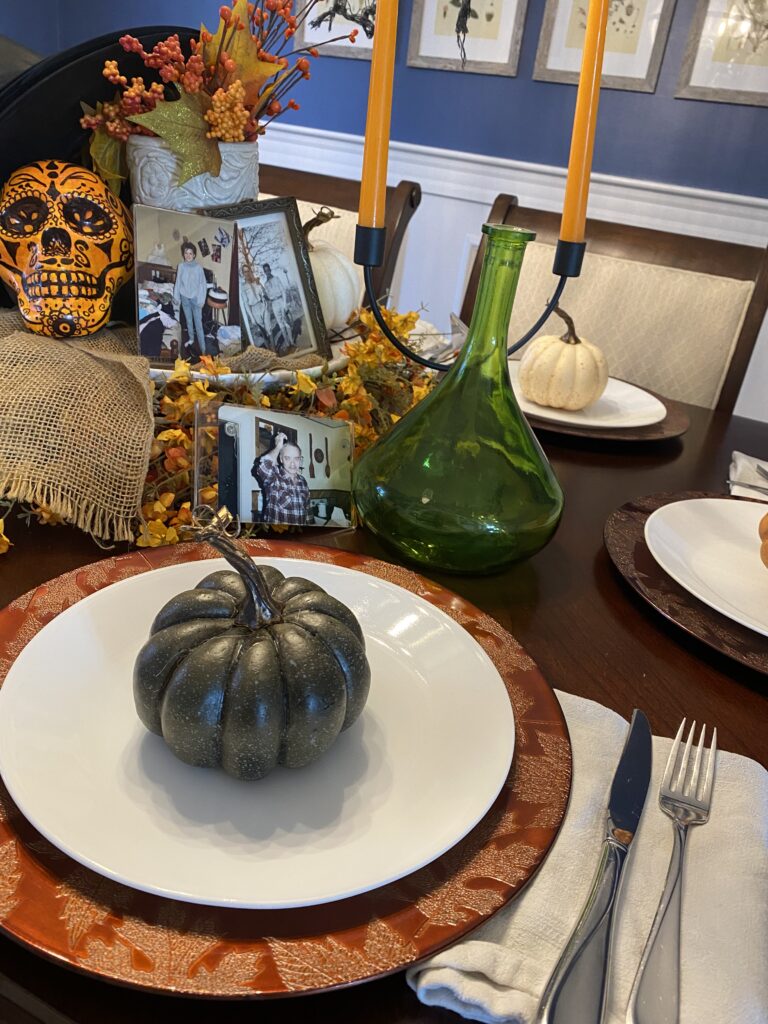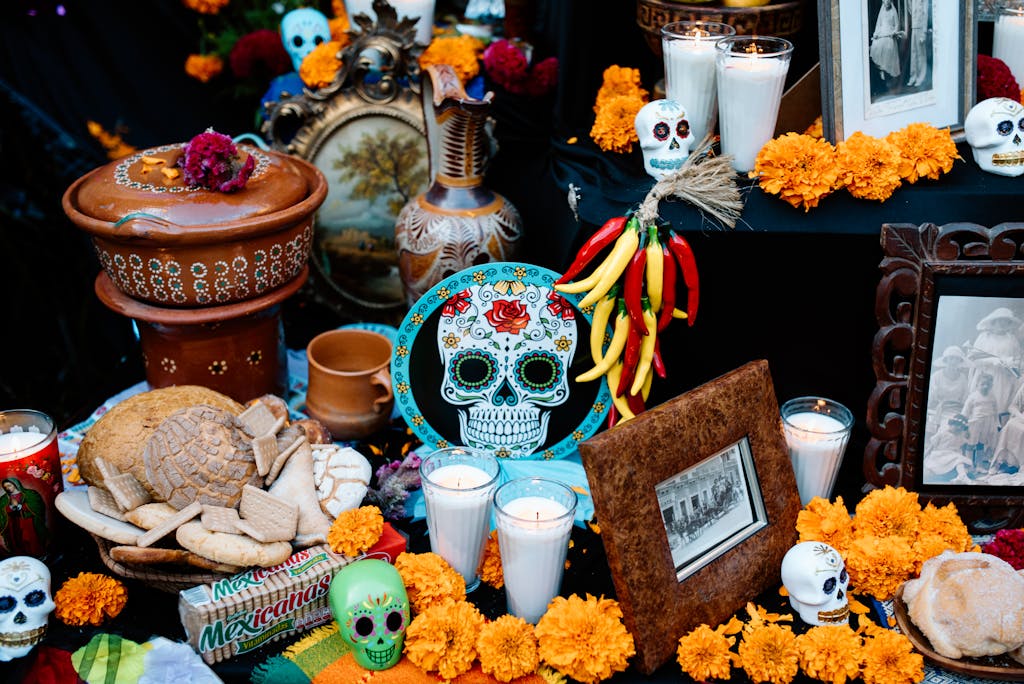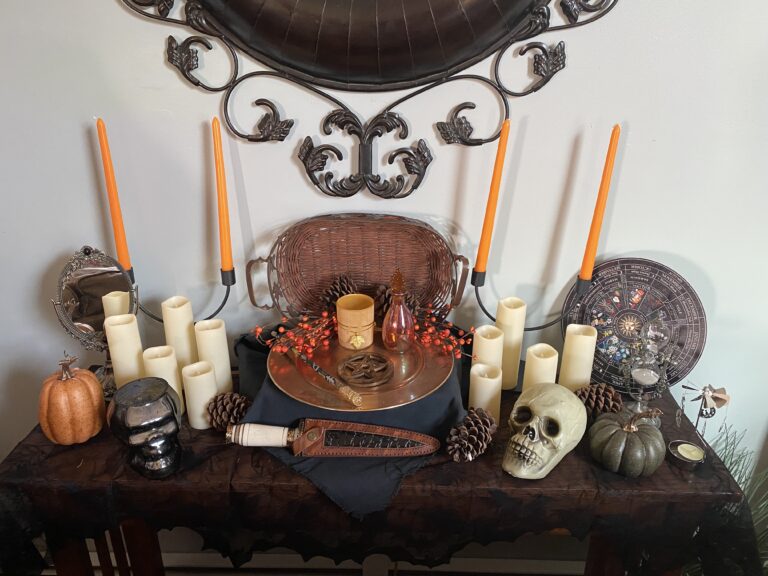Should You Hold a Dumb Supper?
When delving into the rich tapestry of Pagan traditions from around the world, one intriguing and soulful practice that has always stood out to me is the Dumb Supper. For many who observe it, holding a Dumb Supper serves as a symbolic ritual that blends elements of spirituality, ancestor worship, and communal harmony, but for our family, this special dinner goes one step further. We’ve recently begun blending the traditional Celtic celebratory practices with Toltec traditions that honor life.

But where did it all begin? And why call it a dumb supper?
Originally the term “Dumb Supper” referred to a ritual feast celebrated on or around Samhain where participants ate in complete silence. The word “dumb” here meant “mute” or “silent.” (As an aside, I feel compelled to mention that just writing these words stirs up my misophonia. The idea of all those chewing sounds around the table with nothing to screen them from my ears! <gasp!> … but I digress…Back to my post…)
The original celebrations were believed to have connections with Celtic ancestor veneration practices. Today, they’re rooted primarily in Samhain night celebrations and may have even expanded into the Mexican celebration Día de (los) Muertos (Day of the Dead) on November 1. But regardless of where and how it is celebrated, one thing is true: wherever this tradition is practiced provides an opportunity to honor and commune with the spirits of our dearly departed.
Today some still follow these traditions exactly as they’ve always been done, and others, like my family, have made a few changes to bring even more meaning to the special feast.
Customs and Practices, Then and Now
1. It all begins with preparing the table:
Setting the table is one of the most crucial parts of the ritual preparation. There may be an extra space or several spaces set at the table for deceased loved ones, symbolically inviting their presence. Some families also place mementos and tokens, such as photographs, letters, or personal belongings of the deceased around the table or on a side table nearby.
There are some who choose to honor only those who have passed since their last Dumb Supper. In these groups, it is believed that the spirits of the deceased hang around each year until the night of Samhain when the veil between the worlds is its thinnest and they are finally able to cross over. For those families, the feast is meant as a final send off to their loved ones.
On the other hand, many others (my family included) celebrate as many of their deceased friends and loved ones as desired, regardless of how long since they’ve passed. If it’s been a year of great losses, we might honor only those lost that year. If we’ve had no or few new losses, we might go with a theme, such as “dads” or “moms” or “friends.” Or we may just fill the table with pictures and mementos of whomever we are thinking about the most that year.
Often times the table has a towering arrangement in the middle, similar to those commonly seen in the Mexican Day of the Dead celebrations, complete with photos, marigolds, and colorful calavera. Here, the tone is not a somber one, but instead it is more of a joyful celebration of the lives well-lived by our loved ones. What you do for your family is completely up to you. We tend to strike a balance between a subdued table and something more joyful by using mostly candid photos that show our loved ones laughing or smiling in their typical element.

2. The Meal:
For the more traditionalists, the cuisine served during a Dumb Supper often holds symbolic meanings or may be favorites of those being honored. Traditional foods can include seasonal vegetables, fruits, nuts, bread, and especially apples and pomegranates—fruits associated with mysteries of life, death, and rebirth.
In our family, we run with the festive atmosphere, often choosing the foods the departed most enjoyed. One year we might order pizza or Chinese food. The following, we may make a favorite dish, like lasagna or prime rib. Every year is different depending on who passed and what they liked.
These celebrations can be as simple or as elaborate as each family decides to make them. If finances are tight or time is short, a quick bowl of mac n cheese eaten mindfully will suffice. What’s important is the quality of the connections made in that time.
3. Silence:
For most one rule remains true: Participants maintain complete silence during the meal, using this quietness as a mindful meditation to remember and connect with the departed or departing spirits. The stillness serves as a contrast to everyday noise, helping us focus on our thoughts and any subtle signs from the spiritual realm that might occur. (And, yes. They sometimes do!)
Families with young children will often find this silence difficult to achieve. For those (or for those with sensitivity to chewing noises) I suggest shortening the period of silence accordingly. Some very young children can only be silent for a minute or two, tops. Don’t stress about it. The spirits who are watching surely don’t mind and may even enjoy the youthful banter at the table.

4. Ritual Acts:
Various acts can add layers of meaning. Telling stories of the deceased can be a fun way to remember them. Lighting candles can signify lighting the way for spirits, while writing messages to the deceased and leaving them by the hearth or on the extra plate can symbolize communication between worlds. Messages can be burned at the end of the celebration to send the messages into the heavens. There are no hard and fast rules. Personalize your Dumb Supper in any way that feels meaningful to you and your family.
5. Ending the Supper:
After the meal, the ritual typically concludes with gestures of gratitude and farewells to the spirits. The Toltecs, however, take this one step further–a tradition I fell in love with the moment I heard it. They take this time to remember that those of us who are still alive have an opportunity to live well, also. We are reminded not to squander our days, to put our talents to good use, and to serve others as best as we can in the time we have left. So nowadays, our dinners end with a toast and each participant stating a special goal for the coming year.
Modern-Day Relevance
Despite today’s frantic pace, the longing for spiritual depth and connection to our departed ancestors and our roots persists. If you don’t believe me, I remind you that almost four million people are subscribed to Ancestry.com at any one time. The desire and need for connection is real, and a Dumb Supper is a great way to maintain those connections as well as to offer a counterbalance to life’s losses and distractions. It’s a wonderful way to strengthen family and community bonds, and it’s a chance for silent appreciation and meaningful engagement with our own mortality.
For me, I find it is also comforting to know that my own family will think of me and set a place at the table for me long after I’m gone. My only hope is that they serve cherry cheesecake, in which case, I’ll be sure to attend every year.






